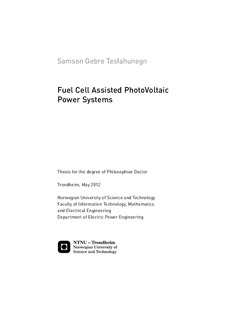| dc.contributor.advisor | Undeland, Tore | nb_NO |
| dc.contributor.author | Tesfahunegn, Samson Gebre | nb_NO |
| dc.date.accessioned | 2014-12-19T13:53:14Z | |
| dc.date.available | 2014-12-19T13:53:14Z | |
| dc.date.created | 2012-07-05 | nb_NO |
| dc.date.issued | 2012 | nb_NO |
| dc.identifier | 539820 | nb_NO |
| dc.identifier.isbn | 978-82-471-3605-8 (printed ver.) | nb_NO |
| dc.identifier.isbn | 978-82-471-3606-5 (electronic ver.) | nb_NO |
| dc.identifier.uri | http://hdl.handle.net/11250/257254 | |
| dc.description.abstract | Distributed generation (DG) systems as local power sources have great potential to contribute toward energy sustainability, energy efficiency and supply reliability. This thesis deals with DGs that use solar as primary energy input, hydrogen energy storage and conversion technologies (fuel cells and water electrolyzers) as long term backup and energy storage batteries and supercapacitors as short term backup. Standalone power systems isolated from the grid such as those used to power remote area off-grid loads and grid connected systems running in parallel with the main utility grid or a microgrid for local grid support are treated. As cost is the key challenge to the implementation of PV-hydrogen DGs, the main focus is developing sound control methods and operating strategies to help expedite their viability in the near future.
The first part of the thesis deals with modeling of system components such as PV generator, fuel cell, lead acid/Li-ion storage batteries, electrolyzer, supercapacitor, power electronic converters and auxiliaries such as hydrogen storage tank and gas compressor. The subsystems are modeled as masked blocks with connectable terminals in Matlab®/Simulink® enabling easy interconnection with other subsystems. The models of main subsystems are fully/partially validated using measurement data or data obtained from data sheets and literature. The second part deals with control and operating strategies in PV hybrid standalone power systems. The models developed in the first part are used to simulate integrated systems. An attempt is made to provide some answers on how the different power sources and energy storages can be integrated and controlled using power electronics and feedback control to enhance improved performance, longer life time, increased supply reliability and minimize fuel use. To this end, new control methods and operating strategies are proposed to mediate near optimal intersubsystem power flows. The third part of the thesis concerns grid connected PV-Fuel cell power systems. Control schemes and operating strategies for integrating PV and fuel cell hybrids into the grid to serve both local demand and weak grids are investigated. How hydrogen energy storage and conversion technologies can be controlled to suppress PV fluctuations in future utility grids are also explored. A smoothing algorithm enhanced by a stepwise constant forecast is developed to enable more smooth and subhourly dispatchable power to be fed to the grid.
The proposed methods were verified through longtime simulation based on realistic irradiance data over a number of typical days/weeks using suitably defined performance indices. It was learned that using power electronics and sound control methods, PV-hydrogen DGs can be flexibly controlled to solve lifetime and performance issues which are generally considered economic bottle necks. For example, conventionally in PV-hydrogen hybrids, to improve performance and life time, more battery capacity is added to operate fuel cell and electrolyzer under more stable power conditions in the face of highly fluctuating PV generation to prevent low state of charge (SOC) operation of the battery. Contrarily, in this thesis a sound control method is proposed to achieve the same objectives without oversizing the battery. It is shown that the proposed method can give up to 20% higher battery mean state of charge than conventional operation while PV fluctuation suppression rates up to 40% for the fuel cell and 85% for the electrolyzer are found for three typical days. It is also established that by predictively controlling battery SOC instead of conventional SOC setpoint control, substantial improvements can be obtained (up to 20-30% increase in PV energy utilization and ca. 25% reduction in fuel usage for considered days). Concerning use of hydrogen storage and conversion technologies in PV fluctuation suppression, results obtained from the developed smoothing mechanism and performance indices show that a trade-off should be made between smoothing performance and dispatchability. It was concluded that the right size of fuel cell and electrolyzer needs to be selected to optimize the dispatch interval and smoothing performance. Finally, a PV-hydrogen test facility which can act as show case for standalone, grid-connected and UPS applications was designed and built. The test facility was used to characterize key subsystems from which component models developed were experimentally validated. The facility also acted as a reference system for most of the investigations made in this thesis. | nb_NO |
| dc.language | eng | nb_NO |
| dc.publisher | Norges teknisk-naturvitenskapelige universitet, Fakultet for informasjonsteknologi, matematikk og elektroteknikk, Institutt for elkraftteknikk | nb_NO |
| dc.relation.ispartofseries | Doktoravhandlinger ved NTNU, 1503-8181; 2012:158 | nb_NO |
| dc.title | Fuel Cell Assisted PhotoVoltaic Power Systems | nb_NO |
| dc.type | Doctoral thesis | nb_NO |
| dc.contributor.department | Norges teknisk-naturvitenskapelige universitet, Fakultet for informasjonsteknologi, matematikk og elektroteknikk, Institutt for elkraftteknikk | nb_NO |
| dc.description.degree | PhD i elkraftteknikk | nb_NO |
| dc.description.degree | PhD in Electric Power Engineering | en_GB |
